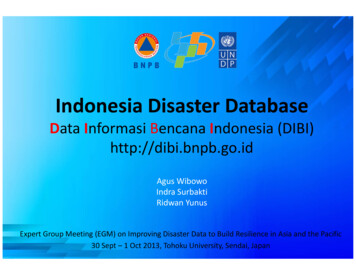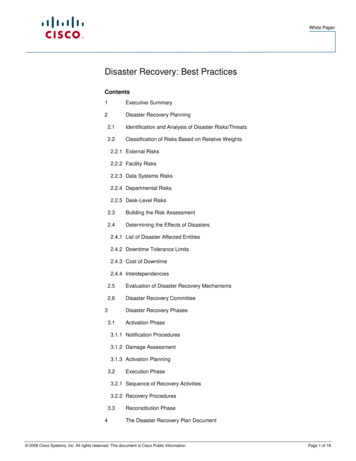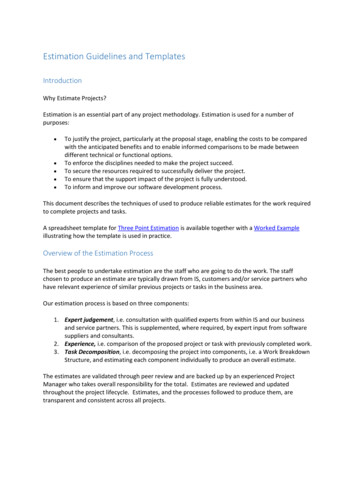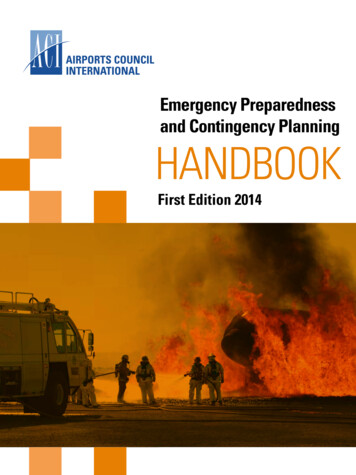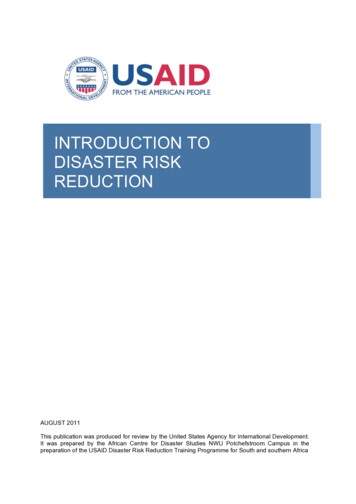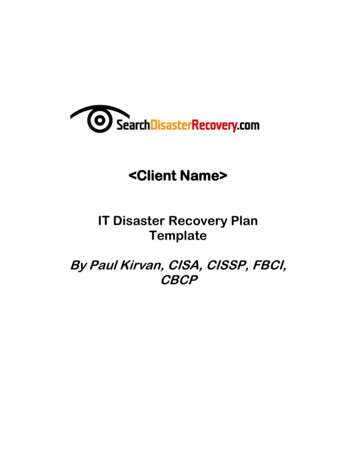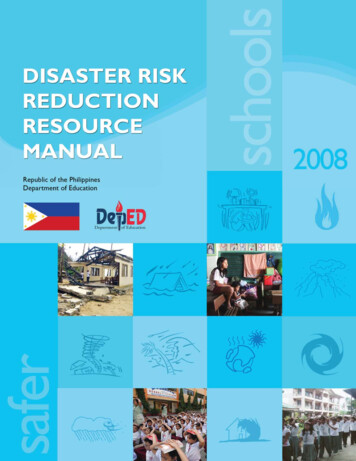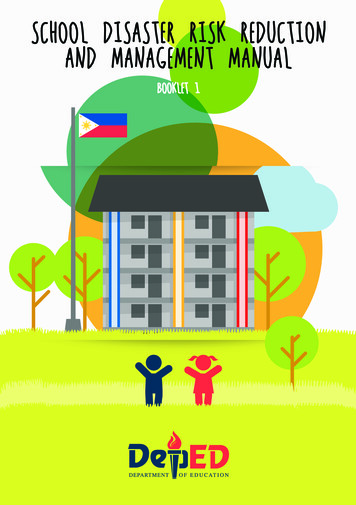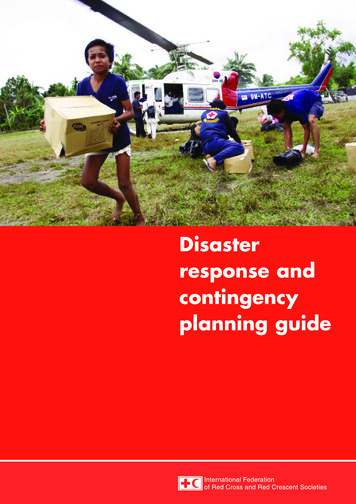
Transcription
Disasterresponse andcontingencyplanning guide
International Federation of Red Crossand Red Crescent SocietiesThe InternationalFederation’s GlobalAgenda (2006–2010)Over the next five years, the collective focus ofthe Federation will be on achieving the followinggoals and priorities:Any part of this handbook may be cited, copied,translated into other languages or adapted to meetlocal needs without prior permission from theInternational Federation of Red Cross and Red CrescentSocieties, provided that the source is clearly stated.The maps used do not imply the expression of anyopinion on the part of the International Federationof Red Cross and Red Crescent Societies or NationalSocieties concerning the legal status of a territoryor of its authorities.Cover photo: Fredrik Barkenhammar/German RedCrossOur goalsGoal 1: Reduce the number of deaths, injuriesand impact from disasters.Goal 2: Reduce the number of deaths, illnessesand impact from diseases and public healthemergencies.Goal 3: Increase local community, civil societyand Red Cross Red Crescent capacity to addressthe most urgent situations of vulnerability.Goal 4: Promote respect for diversity and humandignity, and reduce intolerance, discriminationand social exclusion.Our prioritiesImproving our local, regional and internationalcapacity to respond to disasters and publichealth emergencies.Scaling up our actions with vulnerable communities in health promotion, disease preventionand disaster risk reduction.Increasing significantly our HIV/AIDS programming and advocacy.Renewing our advocacy on priority humanitarian issues, especially fighting intolerance, stigmaand discrimination, and promoting disaster riskreduction.2007International Federation of Red Cross andRed Crescent SocietiesP.O. Box 372CH-1211 Geneva 19SwitzerlandTelephone: 41 22 730 4222Telefax: 41 22 733 0395E-mail: secretariat@ifrc.orgWeb site: www.ifrc.org
Disaster response and contingency planning guideAcknowledgementsThese guidelines draw upon on a wide variety of documents already produced or in use by NationalSocieties, field delegations, partner organizations and disaster management professionals, as well ason a two-year process of dialogue and collection of best practices and peer reviews from within theInternational Red Cross and Red Crescent Movement. An external inter-agency working group, adisaster management delegates’ working group, and a reference task force also inform these guidelines. The following is a list of the main documents consulted:1Preparation of Community Disaster Preparedness Plans in Community-Based Self Reliance - DisasterPreparedness Manual: A Manual for Red Cross Instructors in the Pacific. International Federation ofRed Cross and Red Crescent Societies, Regional Delegation Suva.2Disaster Preparedness, 2nd edition. Randolph Kent for DHA Disaster Management TrainingProgramme, 1994. Prepared in collaboration with the University of Wisconsin-DisasterManagement Centre and InterWorks.3Guidelines for Disaster Response and Contingency Planning, International Federation of Red Crossand Red Crescent Societies, Pan-American Disaster Response Unit (PADRU), 2006.4Preparedness Planning Module. International Federation of Red Cross and Red Crescent Societies,Disaster Preparedness Training Programme. June, 2000.5Inter-Agency Contingency Planning Guidelines for Humanitarian Assistance. Inter-Agency StandingCommittee (IASC), November, 2001.This publication was made possible by the generous financial support of the European Commission’sHumanitarian Aid Department (ECHO), the United Kingdom’s Department for InternationalDevelopment (DFID) and staff support from the American Red Cross.This guide will serve as a working tool for disaster response staff from within National RedCross and Red Crescent Societies and the International Federation of Red Cross and RedCrescent Societies (the International Federation) working at local, national, regional and global levels.1
2International Federation of Red Cross and Red Crescent SocietiesTable of contentsPlans productionChapter 1Introduction 4How to use this guide 4What is disaster response and contingency planning? 7Response planning process 8Why plan? 8What to plan for? 9Who to plan with? 9When to plan? 10Where to plan? 10Chapter 2Steps for developing disaster responseand contingency plansStep 1: Institutional disaster planningStep 2: Hazard, vulnerability, capacity and risk analysesStep 3: Resource identification and mobilizationStep 4: Early warning, alert systems and triggersStep 5: Linkages and communicationsStep 6: Sectoral responsibilities12131419202122Support informationChapter 3Internal and external coordination 31Internal coordination 31External coordination 32Chapter 4Plan implementation and follow-upTraining and awareness of disaster response and contingency plansExercises and simulationsUpdating and evaluating the plan36363738Chapter 5Plan standards, accountability and linkages 41Standards and accountability 41Linkages between national, regional and international tools (local to global) 43AppendicesAnnexes 47
Disaster response and contingency planning guideAcronymsASEANBPICEPREDENACAssociation of South-East Asian NationsBetter Programming InitiativeCoordination Centre for National Disaster Prevention in Central AmericaCPDCoordination and Programme DivisionDFIDDepartment for International DevelopmentDMISDisaster Management Information SystemDMRFDisaster Management Resource FrameworkDMUDisaster Management UnitDREFDisaster Relief Emergency FundECHOEuropean Commission’s Humanitarian Aid DepartmentEOCEmergency Operations CentreERUEmergency Response UnitFACTField Assessment and Coordination TeamGISGeographical Information SystemsIADBInter American Development BankIASCInter-Agency Standing CommitteeICRCInternational Committee of the Red CrossIDRLInternational Disaster Response LawITInformation TechnologyIOMInternational Organization for MigrationMSFMédecins sans frontièresNATONorth Atlantic Treaty OrganizationNDRTNational Disaster Response TeamNGONon-governmental OrganizationOCHAOffice for the Coordination of Humanitarian AffairsOSCEOrganization for Security and Cooperation in EuropeRDRTRegional Disaster Response TeamSOPStandard Operating ProceduresUNUNDPUnited NationsUnited Nations Development ProgrammeUNICEFUnited Nations Children’s FundUNHCRUnited Nations High Commissioner for RefugeesUSAIDUnited States Agency for International DevelopmentVCAVulnerability and Capacity AssessmentWFPWorld Food ProgrammeWHOWPNSWorld Health OrganizationWell Prepared National Society3
4International Federation of Red Cross and Red Crescent SocietiesChapter 1IntroductionThe International Red Cross and Red Crescent Movement is a world leader in disaster management.Effective preparedness for and response to emergency situations are fundamental elements of itsmandate, and support the fulfilment of basic human rights and respect for humanity. TheMovement’s comparative advantages are its large number of paid and volunteer staff throughout theworld, who are able to respond immediately at local level, and the significant resources of the 186National Societies and the International Federation’s Secretariat. Each of these 186 members basesits actions on the Movement’s seven Fundamental Principles of humanity, impartiality, neutrality,independence, voluntary service, unity and universality.Most National Societies are recognized by their governments as “auxiliary to the public authoritiesin the humanitarian field1”. National Societies and the International Federation are uniquely placedto work with governmental authorities and response agencies, and have the community-based outreach to identify those most at risk and vulnerable to disasters. Activities conducted within eachcountry are delivered through a nation-wide network of volunteers who, in times of disaster, areoften the first to provide assistance to those affected.Most countries periodically face emergencies so severe that international Red Cross Red Crescenthumanitarian assistance is required. These disasters may arise from natural hazards such as earthquakes, floods, droughts and cyclones or from any number of risks, such as food or water shortages,epidemics, environmental or technological disasters, acute economic distress, civil unrest or armedconflict. Refugee outflows and internal displacements are consequences of humanitarian emergencies and are also emergencies in their own right.How to use this guideDisaster response and contingency planning is a responsibility at all levels of the organization. TheInternational Federation recommends that National Societies and International Federation officesdevelop either a multi-hazard disaster response plan with hazard-specific annexes, or several hazardspecific contingency plans to cover high-risk disaster events. Many emergency management procedures are common to all disasters, regardless of the hazards involved.The information provided in the following chapters should be regarded as a guideline, rather thanas strict rules. Planning priorities will differ according to the context and scope of the situation –whether local, national or regional. It is essential to work on response and contingency plans inconsultation and cooperation with those who will have to implement or approve them. Theseguidelines aim to ensure that Red Cross Red Crescent disaster response is consistent and ofhigh quality.1 Statutes of the International Red Cross and Red Crescent Movement adopted by the 25th International Conference of the RedCross at Geneva in October 1986 and amended by the 26th International Conference of the Red Cross at Geneva in December1995. http://www.ifrc.org/Docs/idrl/I290EN.pdf
Disaster response and contingency planning guideThe planning process is as important as the plan itself. In this regard, disaster response and contingency planning should be viewed as an on-going activity, which enables us to test and refine existing plans, integrate new partners, and orient staff and volunteers over time.The main topics covered in these guidelines include: The response planning process; Steps involved in developing the plan; Communication and coordination of disaster response; Plan implementation, training, updating and evaluation; and, Standards, tools and templates.The leadership/management of the Red Cross Red Crescent is responsiblefor ensuring the production, implementation and monitoring of disasterresponse and contingency plans1. Local orcommunity level2. Nationallevel3. Regional andglobal levelsAt branch and communitylevels, National Red Crossor Red Crescent Societiescan play a useful role insupporting the organizationof disaster planningcommittees responsible fordeveloping community-baseddisaster response plans.Use of the InternationalFederation’s vulnerabilityand capacity assessment(VCA) tool and its‘Preparedness PlanningTraining Module’ isencouraged. First-aid training is another example ofRed Cross Red Crescentcontribution to a community’slevel of preparedness. Inaddition, local communitiescan provide a great deal ofinformation regarding theirown risks and capacities.A national disaster responseplan addresses and assesses all potential hazards,evaluates the NationalSociety’s capacity forresponse and describes theapproach to be taken inemergencies. A ‘well-prepared National Society’(WPNS) should follow theplanning process describedin this document. NationalSocieties should each havea national disaster responseplan. Their institutional roleand planned response intimes of disaster should alsobe recognized by theirrespective governments. Thiswas agreed to as part ofthe 2004 InternationalConference’s Agenda forHumanitarian Action.As a function of theInternational Federation’scoordination support role toNational Societies, regionaldelegations and pan-regional disaster response/management units (DMU)must develop risk-areacontingency plans. Risk-areacontingency plans cover aspecific hazard with thepotential to cause destructionon a scale requiring extensive international humanitarian assistance. NationalSocieties and theInternational Federationshould plan for these events,setting out the necessaryrequirements, workingrelationships, and rolesand procedures, as well asidentifying event triggers.Those concerned shouldfollow the planning processdescribed in this document.5
6International Federation of Red Cross and Red Crescent SocietiesThe process to build response and contingency plansWhy plan?What to plan for?Introduction:Common understandingof the process for the developmentof response and contingency planWho to plan with?When to plan?Where to plan?Local levelsSteps for developing disasterresponse and contingency plansNational levelsRegional/global levelsAnnex 1SuggestedstructureAnnex 2Roles andmandateAnnex 8EssentialinformationAnnex 3EmergencycontactsAnnex 6 and 7Areas of interventionbased on capacitiesand resourcesPlan standardsAccountability andlinkagesAnnex 5ScenariobuildingAnnex 9Multisectoralorganizational rolesInternal and externalcoordinationAnnex 11Regional potentialhazardsAnnex 4Hazard/risk analysisand potential needsAnnex 10Preparedness andcapacity buildingPlan implementationand follow upAnnex 12Standard operationalprocedures
Disaster response and contingency planning guide7What is disaster response and contingency planning?Disaster response and contingency planning leads to organizationalreadiness in anticipation of an emergency. This includes managementof human and financial resources, availability of emergency supplies,and communications procedures. Such planning can help mitigate thedestructive effects of a disaster by ensuring timely and effectiveprovision of humanitarian aid to those most in need. Time spent indisaster response planning equals time saved when a disasteroccurs. Delays in providing services can result in needless suffering forindividuals and families affected by a disaster, and create additionalburdens for those responding. Effective disaster response planningleads to timely and effective disaster relief operations. It also helps inbuilding realistic expectations. AIMThis document provides an overviewof the key elements of disasterresponse and contingency planning.This guide is most appropriate forNational Society and InternationalFederation staff responsible fordeveloping disaster response and/orcontingency plans at the local,national, regional or global levels.Institutional disaster planning – This defines the general scope of humanitarianaction that the National Society and/or International Federation will undertake. It is basedon the organization’s institutional mandate, which provides a framework within which itspolicies, strategies, standards and norms, and legal remit can be defined.Disaster response plan – Disaster response planning involves identifying, strengthening and organizing resources and capacities so as to reach a level of preparedness fortimely and effective response to a potential disaster. This includes: determining roles andresponsibilities; developing policies and procedures; and identifying and developinggeneric tools for response (e.g. the use of National Disaster Response Teams (NDRT), information management, etc.). Disaster response planning is preliminary in nature, based oneducated assumptions of risks and hazards, and does not address specific disaster scenarios – as is the case for contingency plans. Once a disaster occurs, plans must then bemonitored, evaluated and adapted to the specific situation.Contingency plans – These are based on specific events or known risks at local, national, regional or even global levels (e.g. earthquakes, floods or disease outbreaks), andestablish operational procedures for response, based on anticipated resource requirements and capacity.Standard Operating Procedures (SOP) – These are a set of standard proceduresthat “operationalise” the disaster response and/or contingency plans. In other words,SOPs specify the way in which individuals or units will carry out their functions under theplan (e.g. alerting and mobilizing NDRT, deploying assessment teams and carrying out theassessment process). The SOPs set out what should be done, how it should de done, whois responsible for implementing what, and specifies available resources. These guidelinesdo not specifically deal with SOPs, but an example is given in annex 12.
International Federation of Red Cross and Red Crescent Societiesdisaster pl anunititr responseetplssana loitnganDiIns8The first level of planning is the broadest,providing a policy framework for humanitarian action based on the institutionalmandate.The second level is oriented to NationalSociety and/or International Federationintervention, according to organizationalstructure and capabilities for response atlocal, national, regional or global levels.ContingencyplansSOPThe third level is specific to an eventand establishes operational proceduresfor direct humanitarian action.Standard Operating Procedures (SOP)must be created to ‘operationalise’ andimplement the plans in disaster response.DisasterFigure 1.1 Connections between response and contingency planningand the overall relationship to institutional planningResponse planning processWhy plan?A well-coordinated plan, which makes best use of the Movement’s combined expertise and resources,is essential for efficient and successful disaster response. During an actual emergency, rapid and effective action is required. For this to happen, disaster response and contingency plans must be in placebefore a disaster strikes – along with the necessary resources. If appropriate action is not taken or ifthe response is delayed, lives may be needlessly lost.It is true that many details remain unknown until an actual disaster occurs. Nevertheless, it is essential to prepare a preliminary disaster plan, which should include: an overview of all available resources; identification of emergency shelter sites; relief activity planning, including the identification of suppliers, warehouses and transportationmeans; identification of emergency water sources; knowledge of customs procedures, for rapid clearance of international assistance; establishment of chains of command and communication procedures; training of response personnel; community education and awareness-raising activities about what to do in case of an emergency;and, identification and implementation of key mitigation and early-warning activities.
Disaster response and contingency planning guideEnsure that plans, focal points and resources are in place to receiveand use external resources when needed.In addition, disaster response and contingency planning helps to ensure a coordinated response: Goals, strategies, roles and responsibilities have been clarified in advance. Relevant information has been gathered and analysed. Potential difficulties have been anticipated and attempts have been made to overcome problems. Relationships with other agencies, associations, non-governmental organizations (NGOs), governments and local actors have been created or strengthened.The increased cooperation and coordination resulting from the planning process is often invaluablein ensuring a timely, efficient and effective response to emergencies, making optimal use of all necessary resources. Furthermore, it can lead to increased collaboration in disaster preparedness and mitigation activities, thereby reducing potential losses in the event of a disaster.What to plan for?These guidelines are designed to assist in the preparation of response and contingency plans for alltypes of humanitarian emergencies, including: complex emergencies, natural and environmental disasters, and other significant crises to which National Red Cross or Red Crescent Societies may berequired to respond – whether with their own resources, with the assistance of sister societies, or withthat of the International Federation and/or the International Committee of the Red Cross (ICRC).Planning should be specific to each context and take into consideration a number of factors including: the situation; the government’s own disaster response plans and capacity; reception and coordination of national, regional or global inputs; potential sources of donor support; the likelihood ofdisaster occurrence; and the vulnerability of the population.Objective criteria must be used in determining where and what to plan for. National Societies andInternational Federation delegations should use hazard maps as a way to prioritize their planning.Additional guidance on the importance of hazard/risk analysis is provided in Chapter 2. In caseswhere resources are limited, a network of response teams and relief stocks must be organized in suchas way as to cover likely risk scenarios – on a district, national or regional basis.Who to plan with?Developing a plan is a question of teamwork. Input and support from a variety of people in different positions (e.g. governance, senior managers, sectoral technicians, volunteers, administrative personnel, logisticians, etc.), from different levels within the Movement (local, national and regional/global), as well as from external partners (e.g. government, UN partners, NGOs, etc.) will provide crucial assistance to those who are doing the planning. See Chapter 3 for additional guidanceon the importance of coordination – both internally and externally.In formulating and updating planning assumptions and objectives, National Societies should communicate with governmental agencies and NGOs involved in disaster response, with a view to coor-9
10International Federation of Red Cross and Red Crescent Societiesdinating their respective response and contingency plans. Similarly, Red Cross Red Crescent staffmembers responsible for regional or global disaster response planning must consult with partnerswithin the Movement. This will help to improve coordination, reduce duplication of efforts, clarifyroles and expectations, and increase the overall effectiveness of disaster response. Direct coordinationenables National Societies and International Federation delegations to divide responsibilities andplan their actions accordingly.Planning is most effective when it is a participatory process that (ideally) includes all the actors whowill be required to work together in the event of an emergency. A response or contingency plan mustbe a dynamic document and planners should encourage screening, critique and discussion fromthose who must approve and/or implement its components. This means the plan should be widelydisseminated and communicated to National Society board members, headquarters offices anddepartments, branches, volunteers, and relevant external agencies or organizations.When to plan?Disaster response and contingency planning is an on-going process. Red Cross Red Crescent leadership should include it in the annual planning process, and as part of strategy development and staffaccountability measurements. Plans must be tested and updated regularly to validate their relevance.During rapidly changing situations, plans will need to be updated more frequently; whereas undernormal circumstances, less frequent updating will be sufficient.Resistance to planning can be overcome by promoting its importance even during times of relativenormality, and incorporating it into annual work objectives. A good time to promote the development or the updating of a plan is after a major disaster has occurred. All planning begins with anassessment and analysis of risks, vulnerabilities, capacities, resources and roles.Contingency planning should always be undertaken when there is a high risk/probability that a disaster or emergency situation may occur. National Societies and International Federation delegationsshould also plan in the face of recurring natural disasters, for example seasonal events such as floods,hurricanes/cyclones, etc. Contingency planning should be incorporated into all regular planningprocesses, when relevant.Where to plan?Disaster response plans are necessary at national and other levels (including regional and global), toensure effective coordination and response to large-scale disasters. Plans should be promoted andestablished by all National Societies, and International Federation delegations where applicable,according to the risk, frequency, and complexity of potential disasters. Plans and their implementation processes will differ according to the situation in a specific country and/or region, the institutional framework, geographic scope, etc.
Disaster response and contingency planning guide11National levelNational Societies can have more than one disaster response andcontingency plan, according to the particular needs and geographyof the country – each focusing on main risk areas. Plans can be prepared with different geographical focuses, including local, national,sub-regional and regional anes/cyclonesCross-border level(Between neighbouring countries, or nationally, between neighbouring district/local entities)Most plans are prepared for individual countries; however, plans can also be prepared jointly for anumber of countries or for regions where there are cross-border issues to consider. This is often thecase with large-scale natural hazards, such as hurricanes or cyclones. In such instances, consultationbetween disaster response planners from all affected countries is critical when developing regionalscenarios, which will then inform and shape country-based contingency planning. The InternationalFederation’s regional delegations have madea commitment to support and lead thisEarthquakesregional disaster response and contingencyplanning process.Most countries will also need to developcontingency plans. These are important inresponding to specific threats or for planning within a specific context. However,contingency planning will not always benecessary – particularly in the case of smaller countries, or when the context does notcall for one. In these cases, a disasterresponse plan will be sufficient for theNational Society’s purposes.Country DCountry FRecurrenthurricanes/cyclonesCountry BCountry ACountry CCountry ERecurrentdroughts
12International Federation of Red Cross and Red Crescent SocietiesChapter 2Steps for developing disasterresponse and contingency plansAlthough there are important distinctions between disaster response and contingency plans, thischapter addresses those components that are common to both.Remember that the first level of disaster response planning – institutional – defines the mandate,policies and legal framework upon which the National Society or International Federation will baseits response and contingency plans. Following on this, the disaster response plan outlines risks,response strategies, actions and capacities in a multi-hazard context. Contingency planning, in turn,involves preparing for and scaling-up to respond effectively to very specific risks, which have beenidentified during the disaster response-planning phase.There are six main steps involved in developing disaster response and contingency plans:Step 1 Institutional disaster planningStep 2 Hazard, vulnerability, capacity and risk analysesStep 3 Resource identification and mobilizationStep 4 Early-warning, alert systems and triggersStep 5 Linkages and communicationsStep 6 Sectoral responsibilities Emergency assessment Continuity of operations during an emergency Rescue and medical assistance Health services Water, sanitation and hygiene promotion Food and nutrition Relief Shelter Restoring family links Protection, safety and security Logistics and transport Information technology (IT) and telecommunications Communication and reporting Monitoring and evaluationPlanning will use information from a variety of sources. This information must be dependable, ofhigh quality and serve a specific purpose or objective within the plan. If there are doubts as to theusefulness or reliability of the information, it should not be included.
Disaster response and contingency planning guideAnnex 1 sets out the suggested structure and minimum recommended contents in preparing disaster response and contingency plans.Remember! Contingency plans focus on specific disaster events with a high risk ofoccurrence and linked to high levels of vulnerability; they identify in detail the potentialhumanitarian needs, actions, resources, constraints and gaps. Although both disasterand contingency plans include similar steps, the perspectives from which they are writtenand the level of detail required are different.Step 1Institutional disaster (framework) planningThis first level of planning provides the general reference for humanitarian action, based on the institutional mandate, policies, strategies, standards and norms, and legal framework of the organization.National Red Cross and Red Crescent Societies carry out their humanitarian activities in line withthe Fundamental Principles and Statutes of the Movement, the Constitution of the InternationalFederation, as well as their own statutes and national legislation. As auxiliaries to their governmentsin humanitarian service, Nation
The leadership/management of the Red Cross Red Crescent is responsible for ensuring the production, implementation and monitoring of disaster response and contingency plans 1. Local or community level At branch and community levels, National Red Cross or Red Crescent Societies can play a useful role in supporting the organization of disaster .
